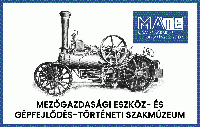SUMMARY
|
In the second half of 19th century the steam engine was the main source of energy in the industry, agriculture and transport. Concerning steam energy applications among the three branches the agriculture was the less developed. The utilization of steam was just still starting when news were spreading in Europe about power machines using different energy source. In the newer engine the fuel was not burned in boiler in their inside in their working cylinder (internal combustion).
In the experiment considering energy sources Guericke, Huygens, Papin used gunpowder (early explosion engine) not thinking that their discovery contained the principle knowledge on explosion engines already in the second half of the 17th century and in the 18th century. The atmospheric fire engine of Newcomen was a great discovery at the beginning of the 18th century.
This gave a great help to forming and developping explosion engines.
That time only the gas was imaginable as a fuel of the early explosion engines. So for instance Rivaz applied oxyhydrogen in 1806. Among other things he found out that gases could detonate, ignite as an effect of compressing (a precursor of diesel engine).
We know a lot of experiment made on gas engine up to 1830, so Humbersin, s. Brown, W. Barnett, R. and J. Stirling had an appreciable activity in this field.
In 1826 J. Ericson caused a sensation with his hot air driven engine. That was the birth of propulsion engine which was used even in the 20th century.
In the progression of internal combustion engines the year 1859 was determinant in two field. The first one connects directly to the explosion engine, namely Lenoir presented his lightinggas driven engine.
There was a second sensatio in 1859. i. e. Edwin L. Drake found mineral oil in Titusville (Pennsylvania) after a long search. In 1867 N. A. Otto patented a standing cylinder engine operating without compression. Still in that year the Otto-Langen atmospheric gas engine what was suitable to fabricate in mass production.
1876: The first four stroke gas engine was finished in the Otto and Langen’s factory. Daimler and Maybach joined the work. They made experiments with a great ardour on the development of electric ignition. Daimler create an ignition device with platinum bar from which the fixed hot-tube ignition evolved and lived on in the form of hot-bulb even in the 20th century. It came clear to the last decades of the 19th century that a placeundependent fuel was needed and the lighting gas was tied to its network. There were experiments on in several places to use the most suitable fuel.
According to otto the ether, light petrol and petroleum could taken into account as liquid fuel.
The decisive turning was in 1887 when R. Bosch constructed a low voltage magnetic ignition device and the mass production started, as well. The production and sale of 21.700 piece four stroke engine in the European factories was a new impulse. There occured the thresher driving lokomobiles, mounted on wheels.
In 1884 the first speeding engine by which the era of the automobile started.
In 1901 the high voltage magnetic ignition occured by R. Bosch.
To the end of the 19th century the Otto engines were fully developed.
The cross-head of steam engines was discarded and built together with the piston. The slide-valve was replaced by the suction valve. Seside lighting gas petrol, diesel oil, petroleum, generator gas and methylated alcohol were already used as fuel.
As for security, continuous work the demand of the man of the turn of the century was satisfied.
The engines developed were made through decades without any considerable change and a great number or of them was operated in the whole word even in the middle of the 20th century.
The agriculture needed engines with the main aim to serve direct driving power. For this reason many type of stable and mobile machine (locomobil) was made. In the Carpathian Basin the number of engine production firms was already a bove thirty in the first decades of the 20th century.
The overdimensioning, durability, simple structure, reliable and modest operation, low number of revolution, economy were the common characteristics of engines for agriculture.
The old engines made for the agriculture was those what kept their simple structure for the longest time, so that samples of them in museums and collections are mainly from the agriculture.
2011 © Minden jog fenntartva!
info@gepmuzeum.szie.hu



